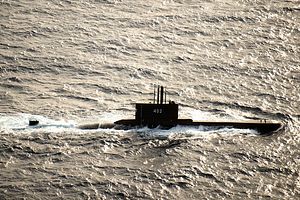On May 17, Indonesia officially witnessed the arrival of the second of three submarines it had ordered from South Korea. The development put the spotlight on Indonesia’s submarine fleet as well as its relationship with Seoul in the defense realm more generally.
As I have noted before in these pages, though Indonesia once operated one of the more capable submarine forces in Asia, today it is woefully underequipped, with just two German-built Type 209 submarines along with the start of gradual integration of three South Korean submarines initially ordered back in 2012. With respect to the submarines from South Korea, one of them was received from Seoul last year, another was set for delivery this year, and the remaining one was set to be constructed in Indonesia in line with the country’s focus on strengthening its domestic defense industry (See: “Indonesia Spotlights Defense Industry Challenge Under Jokowi”).
This week, the second of those submarines finally arrived in Surabaya after traveling for nearly three weeks across the sea from South Korea. The submarine, which will be known as KRI Ardadedali (pennant number 404) once in service, was received by Indonesian officials including the secretary-general of Indonesia’s defense ministry and the navy chief.
The arrival of the second South Korean-built submarine marks the conclusion of a longer delivery process that has been in the works over the past month or so. Indeed, Indonesia had already technically officially received the submarine with a delivery ceremony held on April 25 at the DSME facility in Okpo featuring top Indonesian defense officials including Defense Minister Ryamizard Ryacudu. At the time, it was confirmed that the delivery process would end once the submarine completed its journey from South Korea back home to Indonesia after a few weeks.
Beyond the completion of the delivery process itself, the arrival of the submarine also constitutes a modest and planned addition for Indonesia’s limited submarine capabilities. As I have noted previously it is worth recalling that even with all three of its South Korean submarines, with Indonesia’s Type 209s expected to be decommissioned soon, Jakarta would still be well short of the 12 submarines Indonesian defense officials have themselves said the country needs to police its waters. Though new purchases are being mulled, it is clear that movement has been much slower than it should be.
Finally, the submarine’s arrival also constitutes another step in the realm of South Korea-Indonesia defense cooperation more broadly. Indonesia is already among the biggest importers of South Korean defense equipment, and bilateral collaboration has been focused on projects such as submarines and the joint development of the new KF-X/IF-X fighter aircraft (See: “What’s Next for Indonesia-South Korea Defense Ties?”). Though some elements of that cooperation have run into familiar challenges, both sides have continued exploring areas in this realm as well including during South Korean President Moon Jae-in’s visit to Jakarta last November, from new mechanisms such as a two-plus-two meeting to boosting cooperation in cybersecurity and counterterrorism.

































